5 Management Challenges Construction Firms Will Face After COVID-19
06/19/2020
[ Article was originally posted on www.constructconnect.com ]
By: Derek Jones With confirmed U.S. cases of COVID-19 standing at 1.87 million, with over 108,000 of those cases resulting in death, to have even a fleeting thought of returning to the pre-COVID-19 workloads is not just lofty, it’s wishful thinking. Construction firms are often an early forecast of the financial times because residential construction is normally considered a “luxury” item by the homeowner, and the ability to freeze capital funds in times of uncertain business futures almost guarantees that new construction is the first fat that is trimmed from most budgets. What does this mean for construction firms moving forward? Lots of uncertainty, unemployment, and subcontractors without the financial reserves to withstand the shaky and fearful consumer may very well face bankruptcy. What do construction firms need to prepare themselves for as the country slowly starts to rebuild a sense of normalcy? These five challenges will prove to be nearly universal in the construction industry in post-COVID-19 industry: The Roles and Responsibilities of Managing People in the Construction IndustryIf you’re the superintendent on the job, and you have a crew of sanitary welders that are needed in a food manufacturing facility for emergency weld repairs, are you at the door with a thermometer? Are you collecting doctors notes from your skilled labor stating that they are in good health and can be at the job site without fear of contaminating food products, driving a potential recall, or causing a consumer illness that has the power to ruin even the most trusted of brands right now? If it’s not the superintendent telling the crew to say “aah,” who will perform this function in management? Solution: Construction companies need to assign this administrative task to their payroll or human resources staff and have this documentation at the ready for their crews that are tasked with facilities with heightened screening. Supply Chain Bottlenecking and the Potential Breakdown of the Current Supply ChainIdentifying secondary suppliers early on and keeping raw materials at the ready. You may be employed by a fiscally stable corporation with orders backed up into the first quarter of 2025, but if you can’t get raw material in, you can’t construct a paper sack. What can you do to ensure that the delay in swinging a hammer isn’t because you can’t get your hands on the nails it should be driving in? You act early. There is a time for a secondary and third-string, and this is that time. All of those business cards that you have collected from vendors over the years, that have been in the middle desk drawer in case of emergency? Today is the day to break the glass. Solution: Construction superintendents need to have their supply chains evaluated, and confirm that any secondary suppliers can roll materials to them with expedited lead times in the event that current suppliers cannot deliver. Without New Business, Can You Stay In Business?Without new business slated, due to homeowners becoming unemployed or facing unemployment, and fearful corporate budget overseers chopping the slated capital projects to keep available cash and credit on hand for the “what ifs,” subcontractors are facing bankruptcy in mass numbers and that puts lifelong construction professionals in the unemployment line. In this scenario, it isn’t a bid revision or a warranty on the house that will get a project approved. This is completely out of your hands, and that isn’t something that most construction superintendents are familiar with. Architects reported the slowdown in new business several months ago. In the downhill trek to construction, the prints hung a left at financial catastrophe instead of taking a right at the office of new construction. Solution: Construction superintendents need to be prepared to branch into residential work while it is there and begin bidding state and government agency jobs as they are available in order to land jobs with guaranteed funding, such as government agency work. Will Skilled Labor Still Be There Waiting For Work?If there are mass layoffs due to lack of noncritical construction, those construction professionals will move into jobs that are sending them home with a paycheck while they wait for the industry to recover. In other cases, they will simply move to the area that does have some work for them and put down roots there until the work dries up. The problem with this is not all of those skilled labor providers will return when the projects start to be released for construction. This has the potential to leave construction sites full of green and unskilled laborers. The results are visible in craftsmanship that is subpar at best and projects that are over deadline and over budget. Site superintendents will then attempt to address the punch lists that green labor always leaves in their wake, countless hours and repairs down the drain to keep your client satisfied at the cost of the small profit margin the job had to begin with. Solution: Be prepared to offer pay incentives to your long time, skilled employees. Superintendents need to be ready to serve as utility trainers in the field if the labor shortage mandates it. Travel Bans And Restrictions Hurt Mobile StaffQuarantine and travel bans that are dependent on state and sometimes county leaders don’t bode well for migratory staff, such as construction skilled labor. If your firm is fortunate enough to have a new build in Opa Locka, Florida, but your block masons are all stuck in Atlanta waiting out a travel ban, you now have an entirely new set of problems on your hands. Nearly every skilled labor set has traveling crews. Roofing, welding, demo, carpentry, painting, all of the skilled labor will tell you that they go where the work is. Yet, when travel bans, face masks, and self quarantines threaten to put your contractors in a corner, you’re facing issues that you’ve never faced. It is of the utmost importance to incorporate a Plan B, Plan C, and, yes, even a Plan D. Solution: You should have corporate travel funds ready to wire to your crews if they are caught under travel bans. Open credit lines with rental car agencies that have nationwide locations and ensure your crews have at least one licensed driver traveling with them. Open credit lines with nationwide hotel chains and be prepared to have delayed travel times that may affect the timeline on your open jobs.
All construction professionals have seen lean times at one point or another in their career. It is important to remember that this is not a situation that you can control, and it is best to keep your stress levels as manageable as possible in times of upheaval and change. If you focus on the items that you can rectify, such as identifying new suppliers and combing through bids to ensure that the markups are at a bare minimum to keep the cash flow coming in the door, this can help with the work-based anxiety. Back To News |
|
|
|
ABOUT SBE Inc.
Small Business Exchange Inc., is the ultimate business information hub for small businesses, disadvantaged, Asian, Black, Hispanic Women and Disabled Western-owned Business. Founded in 1984 by Gerald W. Johnson and Valerie, Voorhies, SBE, has been working for over two decades to provide businesses with the most powerful tools available and accurate, up-to-date information about contract opportunities in the public and private marketplaces. CONTACT
Small Business Exchange, Inc.
Phone: 415-778-6250
© 2024 Small Business Exchange, Inc.
|
||
|
|
5 Management Challenges Construction Firms Will Face After COVID-19
06/19/2020
By:
Back To News |
|




